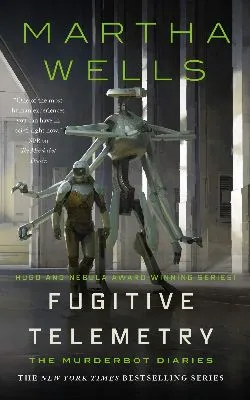
Fugitive Telemetry is the sixth book in the Murderbot Diaries series, and its the first book in the series to take place out of chronological order. Rather than following the previous book in the series, it takes place between Exit Strategy and Network Effect.
This time, the story takes place entirely on Preservation Station, an outpost outside of the Commercial Rim where, in theory, everyone is treated equally. Yet, many chracters have a hard time seeing the protagonist, SecUnit, as a person. While they treat their own bots fairly well, SecUnit is different in that he inhabits an odd liminal space between human and robot.
The story itself is well-written. It follows the classic detective model of storytelling. The book opens with the discovery of an unexplained murder: something nearly unheard of on Preservation. The assumption is that GrayCris, the corporation targeting Preservation’s leader, Mensah, is involved, but this isn’t really the case. What is true is that the story plays with the extent of corporate malfeasance.
I’m not sure how well the plot works for me. While one of the charms of Sherlock Holmes and Agatha Christie’s novels is that, given enough ability to think through the clues, the reader can figure out the crime. I don’t see how that would be possible here, I would have never guessed the true nature of the crime. Instead, we follow SecUnit and his companions as if we are a camera on rails. It makes for an interesting stories, sure, but there are some missteps here that a stronger mystery writer might have accounted for.
Even so, the book is short. As with the other books (except for Network Effect), it’s a novella, and this brevity makes it easy to read and digest quickly. To put everything in place to allow the reader to figure out the murderer, I think that Wells would have needed a full-length text. The Murderbot Diaries has largely pushed against the verbosity that comes with other written fiction, and Fugitive Telemetry does the same.
What Wells does really well–both here and in her other books–is illustrate what an galactic, capitalist humanity might look like. Rather than offer visions of hope and wonder, Wells grants us a glimpse at interplanetary slavery (and attempts to flee it), proprietary software that humans must pay huge sums of money for, and a claustrophobic political system that makes little sense to anyone involved. The stakes are high, and this world is cut-throat.
Preservation acts as a foil to the Corporate Rim. In past books, it appeared increasingly like a hopepunk space Eden, but Wells shatters that image in this book. While things are better on Preservation than many other parts of the galaxy, the people involved are remain flawed and they carry their prejudices. It takes serious work to get through them, and we see a few characters overcome their first impressions of SecUnit.
While Wells started the series as a series of entertaining action novellas, both Network Effect and Fugitive Telemetry are achievements in turning those stories into a living, breathing world. They are especially rewarding books for those who read earlier stories, because things come to fit together in new ways. They’re worth reading for science fiction fans (although don’t expect anything too realistic) and those who are looking for a fast-paced mystery.